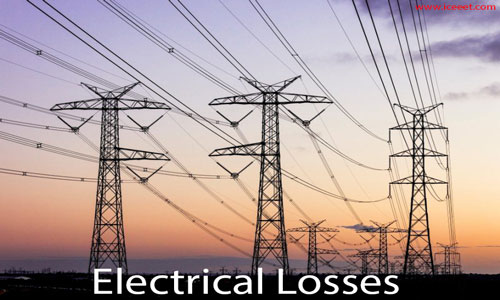Electrical losses happen as electricity travels through power lines, a proportion of energy is lost as heat due to the resistance in the lines. The longer the distance the electricity travels and the lower the voltages of the line – the higher the losses are.
Table of Contents
What Is Electrical Loss?
Electric power losses are a waste of energy caused by external factors or internal factors, and energy dissipated in the system. They include losses due to resistance, atmospheric conditions, theft, miscalculations, etc, and losses incurred between sources of supply to the load center.
Transmission And Distribution Loss
It is fact that the unit of electric energy generated by the Power Station does not match with the units distributed to the consumers. Some portion of the units is lost in the distribution network. This variation in the generated and distributed units is known as Transmission and Distribution loss. Transmission and Distribution loss are those amounts of losses that are not paid for by users.
T&D Losses = Energy Input to feeder(Kwh) – Billed Energy to Consumer(Kwh) / Energy Input kwh x 100
Types of losses
There are two types of losses
a)Technical losses
The difference between actual energy injected into a network and energy actually delivered to points of connection. These losses can result from the unavoidable physical loss of electricity in networks.
b)Non-technical losses/ Commercial Losses
The distinction between the volume of energy actually conveyed at points of connection and the volume of energy reported as conveyed at the same points of connection. These losses can result from stealing, metering errors, and data handling errors.
Technical losses
The technical losses are due to energy dissipated in the conductors, equipment used for the transmission line, transformer, sub-transmission line, and distribution line, and magnetic losses in transformers. Technical losses are generally 22.5% and depend on the network characteristics and the mode of operation.
There are two types of technical losses
a) Permanent or Fixed Technical losses
Permanent losses do not vary according to current. These losses take the form of heat and noise and happen as long as a transformer is energized. Within 1/4 and 1/3 of technical losses on distribution networks are permanent losses. Permanent losses on a network can be affected in the ways set out below
Leakage Current Losses
Dielectric Losses
Open-circuit Losses
Losses due to the continuous load of measuring elements
Losses due to the continuous load of control elements
b) Variable Technical losses
Variable losses change with the amount of electricity distributed and are, more exactly, proportional to the square of the current. Hence, a 1% increase in current leads to an increase in losses of more than 1%.
Within 2/3 and 3/4 of technical losses on distribution networks are variable Losses.
Losses will fall by increasing the cross-sectional area of lines and cables for a given load. This leads to a trade-off between the cost of losses and the cost of capital expenses. It is suggested that the optimal average utilization rate on a distribution network that considers the cost of losses in its design could be as low as 30 percent.
Joule losses in lines in each voltage level
Impedance losses
Losses caused by contact resistance.
Main Reansons For Tecnical Losses
- Lengthy Distribution lines.
- Inadequate Size of Conductors of Distribution lines.
- Installation of Distribution transformers away from load centers.
- Low Power Factor of the secondary and primary distribution system.
- Bad Workmanship.
- Feeder Phase Current and Load Balancing.
- Transformer Sizing and Selection.
- Balancing 3 phase loads.
- Switching off transformers.
How To Reduce Technical Losses?
- Converting LV Line to HV Line
- Large Commercial or Industrial Consumer get direct Line from Feeder
- Adopting High Voltage Distribution Service for Agricultural Customer
- Adopting Arial Bundle Conductor (ABC)
- Reduce Number of Transformers
- Utilize Feeder on its Average Capacity
- Replacements of Old Conductor or Cables
- Feeder Renovation or Improvement Program
Non-Technical / Commercial Losses
Non-technical losses are at 16.6% and related to meter reading, faulty meter and error in meter reading, billing of customer energy consumption, lack of administration, financial constraints, and estimating the unmetered supply of energy are also energy thefts.
Main Reasons for Non-Technical Losses
- Power Theft.
- Metering Inaccuracies.
- Unmetered Losses for very small Load.
- Unmetered Supply.
- Error in Meter Reading.
- Billing Problems.
How To Reduce Non-Technical Losses?
- Making mapping or Data of Distribution Line.
- Implementation of Energy Audits Schemes.
- Mitigating power theft by Power theft checking Drives.
- Reduce Debit areas of Sub-Division.
- Loss Reduction Programmed.
Power Stage Of Electrical Transmission

Owner Of ICEEET




